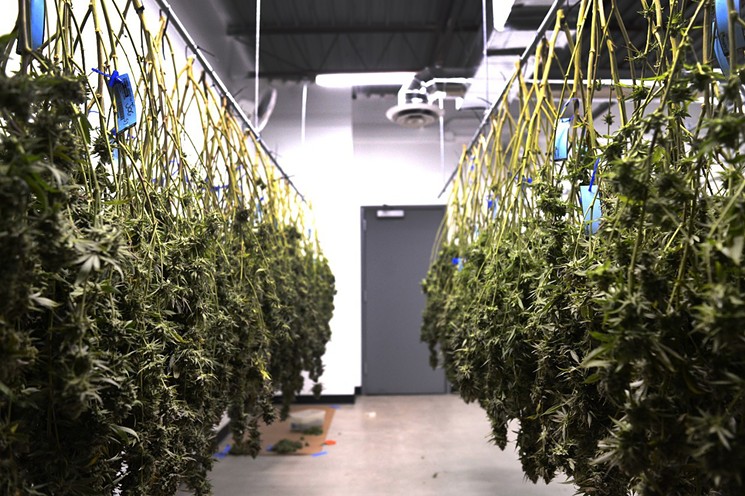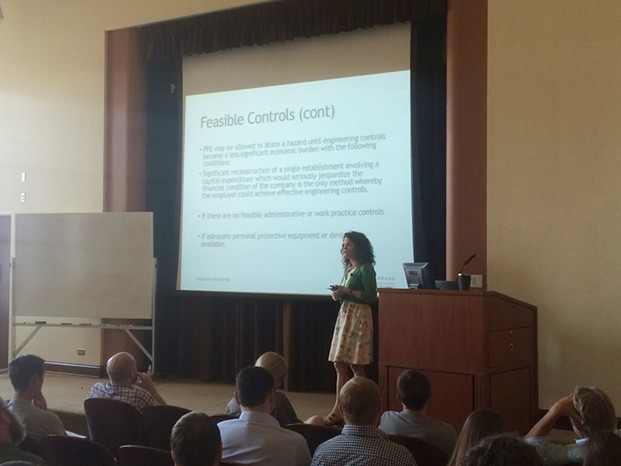State and federal agencies joined forces at the University of Colorado Anschutz Medical Campus on June 28 to teach a full class of cannabis industry employees about health and safety practices in the workplace.

Marijuana flower hangs to dry before trimming in a commercial cultivation facility.
The class, co-hosted by the Center for Health, Work & Environment at the Colorado School of Public Health and the Colorado Department of Public Health and Environment in the same room where President Dwight D. Eisenhower stayed when he was recovering from a heart attack in 1955, offered instruction on safety precautions and hazards specific to the cannabis industry from reps of the CDPHE and the Occupational Safety and Health Administration, and safety consultants from 3M and Pinnacol Assurance.
“Most of you probably know a lot of this already, but these are just the proper terms and definitions,” said CDPHE Occupational Health Program Manager Roberta Smith as she discussed safety controls in front of nearly 100 budtenders, trimmers, general managers and various employees and employers in the cannabis industry.
The day-long class focused on a workplace safety guide released by the CDPHE in February, with presentations on respiratory protection, machine guarding and ergonomics tailored to commercial cannabis. The CDPHE had always planned to have a class to follow up for more hands-on learning, according to Smith, and the industry response impressed public health officials.
“Every worker needs this type of training, no matter the industry. It’s so awesome to see this participation and thirst for knowledge,” she added.

Roberta Smith, manager of the Colorado Department of Public Health and Environment’s Occupational Health Program, talks to cannabis industry employees about avoiding work hazards.
Thomas Mitchell
While some of the advice was standard for many industries, much of the course offered specific insight on safety issues for which cannabis business owners have few templates. Having an ergonomically-friendly table height for bud trimmers, proper training for temporary workers and precise pesticide application times might seem like common sense, but the training requires adequate planning, according to Joshua Scott, director of education for the Center for Health, Work & Environment.
“It’s the repetitive stuff you don’t think about,” he said. “It’s the slips, trips and falls, lighting issues or even table ergonomics. There’s a lot of different considerations.”
In an interactive poll of attendees, 92 percent said they had some changes to make in the workplace. The high number is a good sign, Scott told the group, showing willingness for transparency and improvement among cannabis businesses. “When I see that, it’s not scary, it’s really encouraging,” he explained. “If you can take just one safety improvement back from this course, then we’ve done our job.”
The course also covered workplace safety and crime, including how to protect employees from robberies in an all-cash businesses and why facilities should be updated from the industry’s earlier days, when there was less regulation and oversight.
Emerging industries traditionally resist regulatory changes at first, then accept them as they become more established, Scott said. Comparing the emerging cannabis sector with Colorado’s craft-beer industry, he noted a lot of similarities. “They’re, like, ten years ahead. A lot of it started out of people’s basement, brewing beer and being passionate about it. They have a really cool culture,” he said of craft-beer employers. “There’s an advantage in working in these industries: Most of these employers care about their products and employees.”
Another focus of the course was teaching employees and employers how to seek help when they see problems. OSHA offers free safety consultations for dispensaries despite marijuana’s federally illegal status, and also hosts an anonymous tip line and protection for employees scared to speak out about dangerous work practices.
“There are protections for workers in this industry. This is a recognized industry in Colorado,” Smith said.
The CDPHE is holding another class in November with twice the capacity that will also be telecast and available as a webinar.
Link – WestWord




































